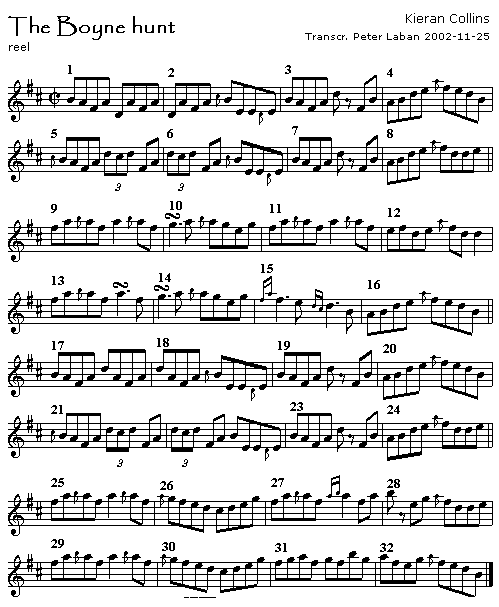Comments and transcription by Peter Laban, 26 November 2002
From a recording by Kieran Collins from the 1970s. This is the second tune in a selection of reels, the first of which, Rolling in the ryegrass, was transcribed here earlier.
The Boyne hunt is a popular reel which is associated with the great accordion player Joe Cooley who, like Kieran Collins was from the Gort/Peterswell area of Co. Galway. A Scottish pedigree is usually ascribed to the tune, having started out as The Perthshire hunt.

Bars 1-4. Collins opens the tune in standard fashion, raising the D in bar 3 an octave to great effect while creating a nice rhtyhmic touch as well as a breathing space. His playing of the roll in bar 2 should be noted. Normally written as BE ~E2, Collins here though, like many players of his generation, does not employ the now standard cut-tap configuration in his roll. He taps the note once and separates the others by blowing but without actually tongueing the note.
Bars 5-6. Here he elaborates on the idea introduced in bar 2 but here the raised D becomes a triplet, sounding very much like a cran (and I think achieved by slowly cutting with A, as a piper would treat a bottom D rather than actually playing a d c d triplet).
Bars 7-8 resolve the first part pretty much as could be expected.
Bars 9-12. In the first half of the turn Collins does not use long rolls on a as one may have expected but sticks with a followed by af. In bar 10 there's some melodic compression where the standard setting would go bgeg but Collins plays ageg.
Bars 13-16. In the second half of the turn Collins opts for the a roll. It is also worth noting that while f and d in bar 15 sound rolled but are in fact closer to a triplet, not quite a triplet but close.
Bars 17-24. Please note not the actual second playing in the soundclip is transcribed here but the third playing. The first part uses very much the same devices used in the first playing, they are arranged effectively in a slightly different configuration though.
Bars 25-32. The turn of this playing is treated to a large-scale melodic variation. This speaks to a large extent for itself: there are some nice effects where the tune moves downward when expected to go up, then next going up instead of down, culminating in a pleasantly rhythmic high b followed by a tiny breathing space in bar 28 for example. He wraps up this playing with a flourish in bars 31-32.
Please note the transcription was done with an imperfect ear, I wrote what I thought I heard. As always, the transcription is meant as a guide, offering hopefully some insight in a style of playing. It is not intended as a standard setting that should be learned by heart. It is hoped it may provoke some ideas useful to the playing of the reader.
Peter Laban, 26 November 2002